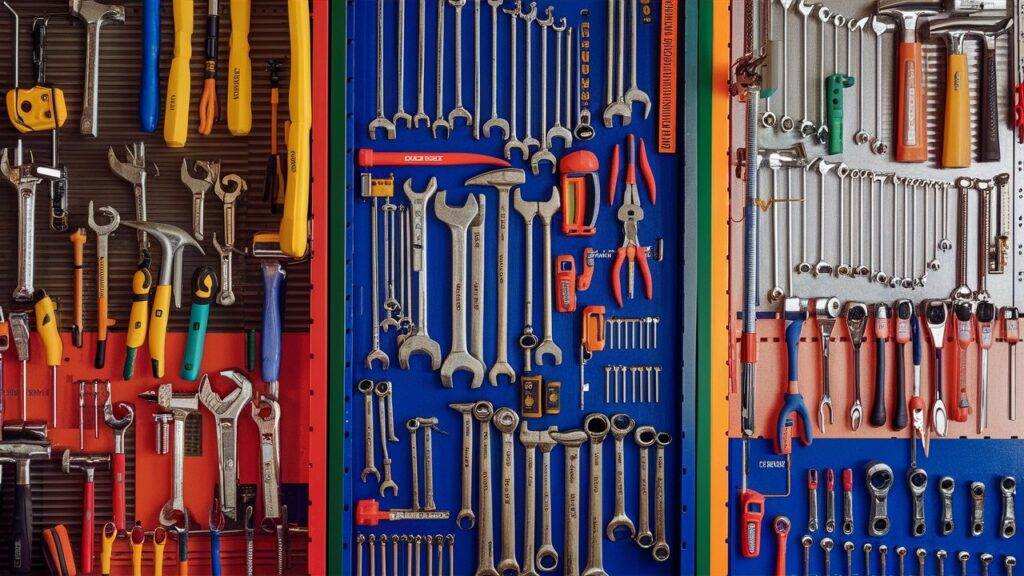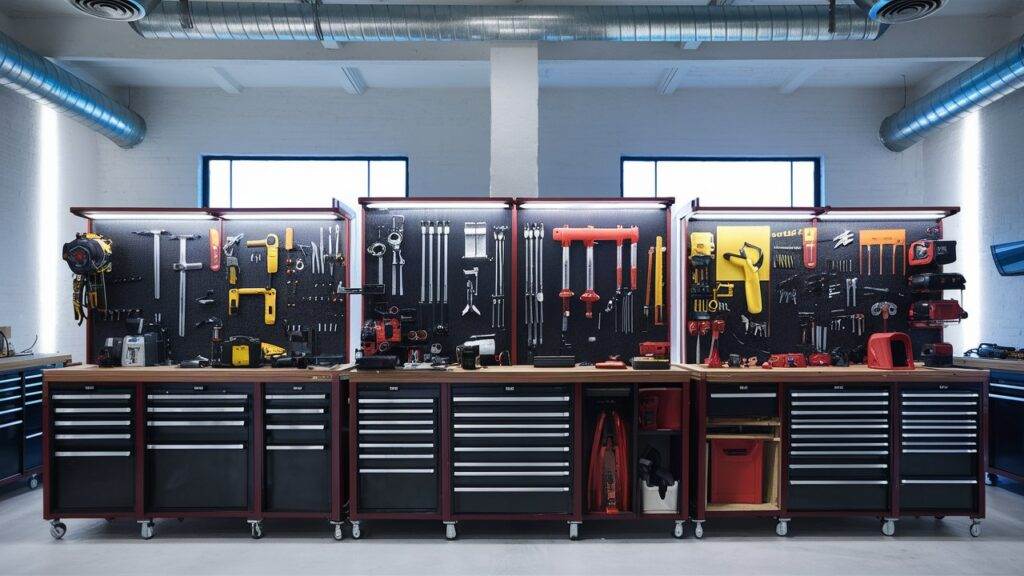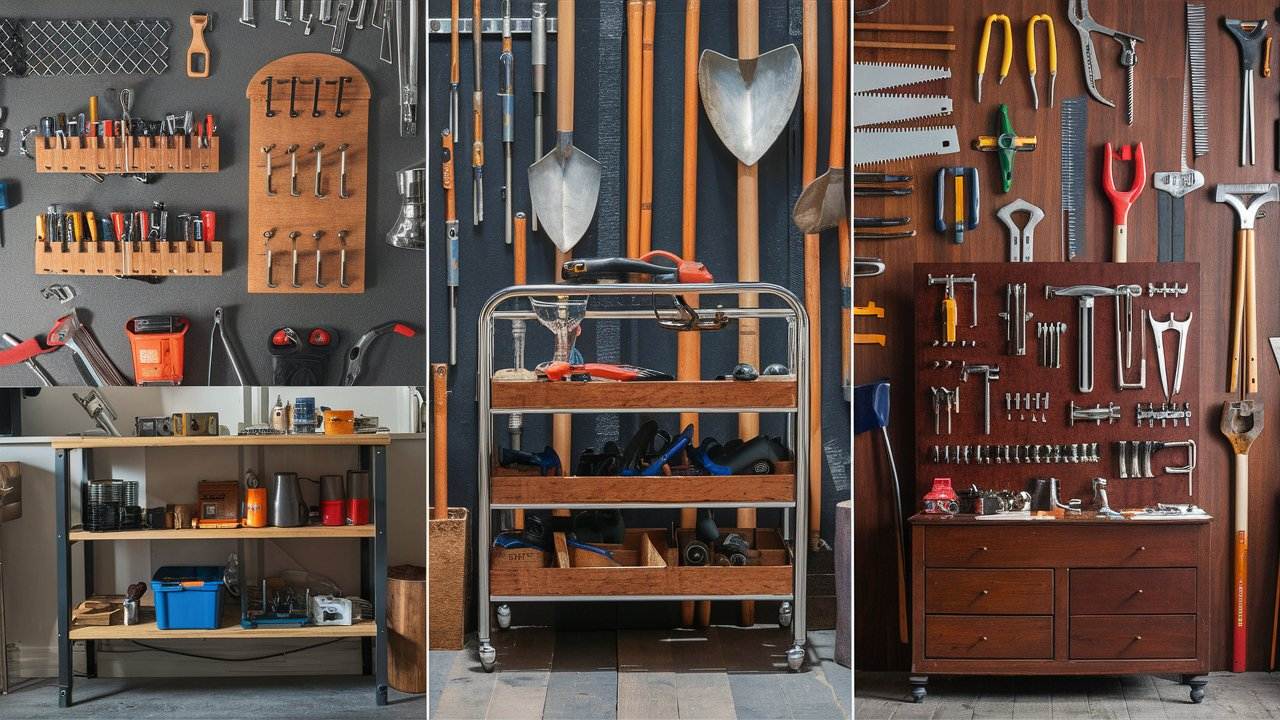Get a detailed guide on the different types of tool racks available for all your tool storage needs. Find out which tool storage racks are best.
Types of Tool Racks- An Overview
Tool racks are super important for keeping your workspace tidy, whether it’s in a garden shed or a workshop. There are many different types to fit what you need. Knowing the types of tool racks can help you pick the right one for your space.
Wall-Mounted Tool Racks
Wall-mounted tool racks are great because they use vertical space and keep tools close by. They’re perfect for small areas where there isn’t much floor space. Some common wall-mounted options are pegboards and magnetic strips.
Pegboards are really flexible! You can add hooks, shelves, or bins to store different tools like hand tools or gardening gear.
Magnetic strips let you quickly grab metal tools like screwdrivers and pliers. They keep tools visible while saving room on your work surface.
If you’re storing outdoor tools, look for weather-resistant wall-mounted racks. These will help keep your gardening tools organized without getting rusty.
Freestanding Tool Racks
Freestanding tool racks give you flexibility and can be moved around easily. This is handy in bigger workspaces where you might want to change things up.
One option is rolling carts that you can push wherever you need them. They often have shelves or compartments for different kinds of tools.
Another choice is vertical storage units, which make good use of height while giving enough space for larger items like power tools. Many of these units have adjustable shelves to fit various tool sizes.
Specialty Tool Racks
Specialty tool racks are made for specific jobs, like gardening or heavy-duty tasks. These racks usually come with special features that make it easy and safe to store certain types of tools.
For example, garden tool racks often have slots or hooks designed just for long-handled tools like rakes and shovels. This keeps everything organized and prevents damage.
Heavy-duty tool racks are built to hold heavier equipment such as drills and saws. They use strong materials so they can support more weight while still being easy to access.
DIY fans might also enjoy making their own custom solutions using parts that fit their needs just right!
Factors Influencing Your Choice
When you’re picking a type of tool rack, think about how strong it needs to be, how much money you want to spend, and how much space you have available.
Durability matters because it shows how long the rack will last when used regularly. Look for materials that won’t wear out easily, especially if you’ll store heavier items on them.
There are budget-friendly options in all kinds of tool racks! Sometimes spending a little more on quality means better results in the long run.
If you’re tight on space, look into wall-mounted options since they take up less room than freestanding ones that need floor space.
By checking out these different types of tool racks and knowing their benefits, you’ll be able to choose one that helps make your workspace more efficient!
Wall-Mounted Tool Racks
Pegboard Tool Racks
Pegboard tool racks are a great way to keep your tools organized in gardens and workshops. They let you customize how you store your tools, making it easy to rearrange them when needed. One of the best things about pegboards is that they help you use vertical space, so your tools are easy to reach.
When picking pegboard materials, you have a few options:
- Wooden Pegboards: They look nice but might not last as long as metal ones.
- Metal Pegboards: These can hold heavier tools and won’t bend or break easily.
- Plastic Pegboards: They’re light and good against moisture but may not support heavy items.
To organize your tools on pegboard racks, try grouping them by type or how often you use them. For instance, keep the tools you use most at eye level. Using hooks and shelves smartly can make it easier to find what you need while keeping everything neat.
Magnetic Tool Racks
Magnetic tool racks are cool because they use strong magnets to hold your tools in place. These racks are usually made from tough steel or aluminum, which makes them durable.
When choosing a magnetic rack, check how strong the magnets are. They should be able to hold different hand tools without dropping them. A good magnetic tool rack can hold things like hammers, screwdrivers, and pliers without any trouble.
These racks work well in garages and workshops for quick access to tools you use all the time. However, they do have some limits on weight. Heavier items might not stay put safely on these racks.
French Cleat Tool Racks
French cleat tool racks are simple but effective. They have two parts that fit together—one part goes on the wall while the other holds your tools. This system is easy to set up and lets you move things around whenever you want.
To install French cleats right:
- Make sure they’re attached securely into wall studs for strength.
- Use a level so everything stays straight during installation.
- Put heavier items lower down on the cleat system so they don’t fall.
Besides regular hand tools, French cleats can also hold shelves or bins for even more organization. This flexibility makes them useful in different places like workshops and garages.
Overall, wall-mounted tool racks like pegboards, magnetic systems, and French cleats offer smart ways to organize garden and workshop tools efficiently. Each type has its own special features that meet different needs while keeping your workspace tidy!
Freestanding Tool Racks
Vertical Tool Carts
Vertical tool carts are a smart choice for making the most of your workspace. These mobile tool racks are easy to move around and can hold different tools in an organized way. When picking a vertical tool cart, think about what types and sizes of tools you have. Make sure the cart has enough shelf space and compartments to fit your needs.
To keep your vertical tool cart tidy, group your tools by how you use them. For example, put hand tools together and keep power tools separate. This way, you’ll find what you need quickly, and everything will have its own spot.
Horizontal Tool Cabinets
Horizontal tool cabinets give you lots of space for storing larger tools while keeping them safe from dust and damage. These cabinets usually have multiple drawers or shelves that can be set up to hold different kinds of tools.
When selecting a horizontal cabinet, check for features like lockable drawers for security and strong materials like metal or high-grade plastic. Think about where you’ll place the cabinet; it should fit well in your area without blocking pathways.
For using horizontal cabinets effectively, arrange your tools by how often you use them. Keep the items you use daily at eye level and store less-used items on higher or lower shelves.
Rolling Tool Cabinets
Rolling tool cabinets mix portability with usefulness, making them great for various workspaces. These heavy-duty tool racks roll easily while providing secure storage for different tools. When looking at a rolling cabinet, pay attention to how much weight it can hold and how durable the wheels are to ensure it can handle heavy loads safely.
Features like drawer dividers and built-in power strips can help keep things organized inside these cabinets. You might also want to label drawers or use color-coded bins to make finding things easier.
To keep rolling cabinets organized, check which tools you use most often and change the contents as needed. This will save time during projects.
Choosing the right freestanding tool rack means understanding your needs regarding space and types of tools. Each option has its perks—whether it’s mobility with vertical carts or secure storage with horizontal cabinets or rolling units—pick wisely based on what works best for your workspace!

Tool Racks for Specific Applications
Garden Tool Racks
Garden tool racks are super helpful for keeping your gardening tools organized and easy to find. They help you tidy up your outdoor space. There are different styles of garden tool racks, each made for specific needs.
Wall-Mounted Garden Tool Rack
A wall-mounted garden tool rack is great for saving space. It uses vertical areas to keep your tools within reach while clearing up the floor. This type is perfect for small gardens or places with limited storage.
Hanging Style Gardening Tool Racks
Hanging style gardening tool racks let you grab your most-used tools quickly. These racks keep tools off the ground, which helps prevent damage and makes them easy to see when you need them.
Shelf-Style Gardening Tool Racks
Shelf-style gardening tool racks add extra storage for smaller items like seeds, gloves, and pots. You can put them in sheds or garages where more organization is helpful.
When picking a garden tool rack, think about what types of tools you have. Long-handled tools need taller storage options, while hand-held ones fit better on shelves or hooks. Also, consider using weather-resistant materials if the rack will be outside.
Heavy-Duty Tool Racks
Heavy-duty tool racks are built to hold a lot of weight and can handle tough use. These racks work well in workshops or garages where bigger power tools need solid storage.
Made from strong materials like steel or reinforced plastic, heavy-duty tool racks provide great support for heavy items such as drills and saws. When selecting a heavy-duty rack, check its load capacity and construction quality to stay safe while using it.
Always follow safety guidelines with heavy-duty tool racks. Make sure the rack is anchored securely so it doesn’t tip over when loaded with equipment. Regularly inspect the condition of the rack to keep everything safe in your workspace.
Specialty Tool Racks
Specialty tool racks focus on specific types of tools like power tools, hand tools, or precision instruments. Proper storage helps extend the life of your equipment and keeps your workspace organized.
For power tools, look for sturdy shelving that can support their weight while allowing easy access during projects. Hand tools do well on pegboards or magnetic strips that keep them visible without taking up much room.
Precision instruments need careful handling; dedicated cases or drawers with soft interiors are best for storing these items safely. When choosing specialty tool racks, think about how often you use each type of tool to find the best spot in your workspace.
Understanding different types of tool racks—garden tool racks, heavy-duty options, and specialty designs—can help you pick the right solution based on what you need and how much space you have available.

Factors to Consider When Choosing a Tool Rack
Type of Tools
When picking a tool rack, knowing the types of tools you have is super important. Different tools need different kinds of storage based on their size and shape. For example, garden tool racks are made for long-handled tools like rakes and shovels. These racks usually have hooks or slots that fit these tools well, keeping everything neat and easy to grab.
On the flip side, power tools need special storage options to keep them safe and easy to find. A good power tool storage system might have shelves with spots for batteries and other small parts, plus secure areas for larger items. Grouping your tools into hand tools, power tools, and gardening equipment can help you figure out the best way to store them.
Space Constraints
Space can be a big deal when you’re choosing a tool rack. Take a look at where you want to put your rack—like in your garage or shed. If space is tight, think about using vertical storage solutions that make the most of your floor area while giving enough room for all your tools.
Wall-mounted options work great in small spaces because they let you use wall space without taking up any floor room. Compact shelving units are also handy for organizing smaller items efficiently. Checking out your available space will help you choose the right type of tool rack that fits just right.
Budget
Your budget plays a big role in what kind of tool rack you can get. Tool racks come in many materials—from cheap plastic ones to stronger metal options. It’s smart to compare prices while keeping an eye on quality.
Spending a bit more on durable materials might save you money later by cutting down on replacement costs from wear and tear. Look for affordable tool racks that still offer strength, like metal storage systems that last longer than cheaper choices.
Durability
Durability matters when you’re choosing a tool rack because it affects how long it will last and how well it works over time. Look for heavy-duty options made from strong materials built to handle everyday use. If you’ll be using it outside, consider racks with rust prevention features or weather-resistant qualities if they’ll be exposed to rain or humidity.
A sturdy rack not only protects your investment but also keeps your tools safe from damage caused by poor storage solutions.
Additional Considerations
Customization can really help when picking out the right tool rack for your needs. Some brands offer modular or adjustable designs that let you change things around based on what you need at any given time. This flexibility is useful if your collection grows or changes as you get new gear.
For instance, customizable tool racks can adjust as your needs shift from gardening supplies to home improvement projects. This way, you’ll always have an organized spot no matter how many tools you’ve got.
By looking at these factors—what types of tools you need to store, how much space you’ve got available, what fits within your budget, and how durable the options are—you’ll be better prepared to choose the right type of tool rack for yourself!

